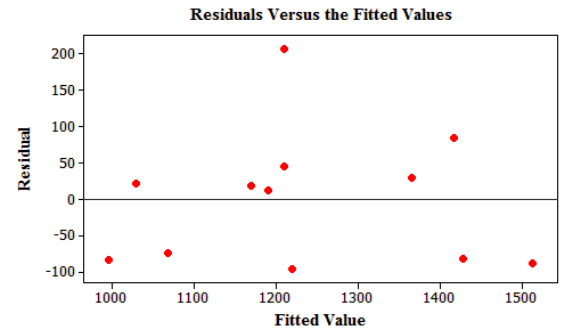
(a)
To make:a residual plot and describe how the line fits the data.
(a)
Answer to Problem 56E

Explanation of Solution
Calculation:
The figure shows a random scatter of points in a horizontal band centered at zero. Most of the residuals are between

Conclusion:
Therefore, the residual plot is drawn.
Prediction error of 200 is relatively large compared with the actual metabolic; line does not fit the data accurately.
(b)
To find: the point which has the largest residual
(b)
Answer to Problem 56E
The point
Explanation of Solution
Calculation:
The below table shows the values of predicted Y and residuals
| Mass (kg) (X) | Metabolic rate (cal/24hrs) (Y) | Predicted Y (Y) | Residuals (Y-Y) |
| 36.1 | 995 | 1068.503 | |
| 54.6 | 1425 | 1512.985 | |
| 48.5 | 1396 | 1366.426 | |
| 42 | 1418 | 1210.256 | |
| 50.6 | 1502 | 1416.881 | |
| 42 | 1256 | 1210.256 | |
| 40.3 | 1189 | 1169.412 | |
| 33.1 | 913 | 996.4244 | |
| 42.4 | 1124 | 1219.867 | |
| 34.5 | 1052 | 1030.061 | |
| 51.1 | 1347 | 1428.894 | |
| 41.2 | 1204 | 1191.036 |
From the table, the point
Conclusion:
Therefore, the point
Chapter 3 Solutions
The Practice of Statistics for AP - 4th Edition
Additional Math Textbook Solutions
Statistical Reasoning for Everyday Life (5th Edition)
Basic Business Statistics, Student Value Edition
Basic Business Statistics, Student Value Edition (13th Edition)
Statistics: The Art and Science of Learning from Data (4th Edition)
Elementary Statistics: Picturing the World (7th Edition)
 MATLAB: An Introduction with ApplicationsStatisticsISBN:9781119256830Author:Amos GilatPublisher:John Wiley & Sons Inc
MATLAB: An Introduction with ApplicationsStatisticsISBN:9781119256830Author:Amos GilatPublisher:John Wiley & Sons Inc Probability and Statistics for Engineering and th...StatisticsISBN:9781305251809Author:Jay L. DevorePublisher:Cengage Learning
Probability and Statistics for Engineering and th...StatisticsISBN:9781305251809Author:Jay L. DevorePublisher:Cengage Learning Statistics for The Behavioral Sciences (MindTap C...StatisticsISBN:9781305504912Author:Frederick J Gravetter, Larry B. WallnauPublisher:Cengage Learning
Statistics for The Behavioral Sciences (MindTap C...StatisticsISBN:9781305504912Author:Frederick J Gravetter, Larry B. WallnauPublisher:Cengage Learning Elementary Statistics: Picturing the World (7th E...StatisticsISBN:9780134683416Author:Ron Larson, Betsy FarberPublisher:PEARSON
Elementary Statistics: Picturing the World (7th E...StatisticsISBN:9780134683416Author:Ron Larson, Betsy FarberPublisher:PEARSON The Basic Practice of StatisticsStatisticsISBN:9781319042578Author:David S. Moore, William I. Notz, Michael A. FlignerPublisher:W. H. Freeman
The Basic Practice of StatisticsStatisticsISBN:9781319042578Author:David S. Moore, William I. Notz, Michael A. FlignerPublisher:W. H. Freeman Introduction to the Practice of StatisticsStatisticsISBN:9781319013387Author:David S. Moore, George P. McCabe, Bruce A. CraigPublisher:W. H. Freeman
Introduction to the Practice of StatisticsStatisticsISBN:9781319013387Author:David S. Moore, George P. McCabe, Bruce A. CraigPublisher:W. H. Freeman





